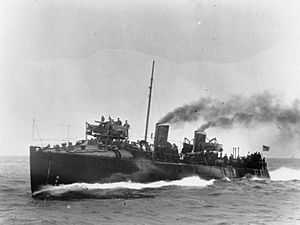HMS Mallard (1896) facts for kids

Fame, sister-ship to Mallard
|
|
Quick facts for kids History |
|
|---|---|
| United Kingdom | |
| Name | HMS Mallard |
| Ordered | 30 May 1895 |
| Builder | John I Thornycroft, Chiswick |
| Cost | £54,715 |
| Yard number | 308 |
| Laid down | 13 September 1895 |
| Launched | 19 November 1896 |
| Commissioned | October 1897 |
| Out of service | Laid up in reserve 1919 |
| Fate | Sold for breaking, 10 February 1920 |
| General characteristics | |
| Class and type | Two funnel, 30 knot destroyer |
| Displacement |
|
| Length | 210 ft (64 m) o/a |
| Beam | 19 ft 6 in (5.94 m) |
| Draught | 5 ft 8 in (1.73 m) |
| Installed power | 5,700 shp (4,300 kW) |
| Propulsion |
|
| Speed | 30 kn (56 km/h) |
| Range |
|
| Complement | 65 officers and men |
| Armament |
|
| Service record | |
| Operations: | World War I 1914 - 1918 |
HMS Mallard was a fast warship called a destroyer. It was built for the Royal Navy (Britain's navy) in the late 1800s. Mallard was known for its speed, being able to travel at 30 knots (about 55 km/h). This ship served in British waters both before and during World War I, helping to protect the country. After the war, it was taken out of service and sold in 1920.
Contents
Building a Warship
Mallard was built by John I. Thornycroft & Company at their shipyard in Chiswick, which is on the River Thames. The ship's construction began on 15 September 1895. It was launched into the water on 19 November 1896. During its tests, Mallard reached an impressive average speed of 30.1 knots. After its weapons were added, the Royal Navy officially accepted the ship in October 1897.
Early Adventures
Once Mallard was ready for duty, it joined the Chatham Division of the Harwich Flotilla. This was a group of ships based in the Medway area, used for training.
A Sad Accident
In April 1900, Mallard was present during a sad accident near Brighton's West Pier. Seven sailors from another ship, HMS Desperate, drowned in bad weather while trying to get to the pier.
Changing Names
In 1912, the Royal Navy decided to give letters to all its destroyer classes. Because Mallard was a 30-knot ship with two funnels, it was placed in the 'D' class. Ships with three or four funnels became the 'C' and 'B' classes. After September 1913, Mallard was officially known as a D-class destroyer. To show this, the letter 'D' was painted on its hull near the bridge and on one of its funnels.
World War I Service
When World War I began in July 1914, Mallard was part of the 8th Destroyer Flotilla. This group of ships was based at Sheerness and worked with a larger support ship called Tyne.
In August 1914, the 8th Flotilla moved to the River Tyne. Here, Mallard helped with important jobs like looking for enemy submarines and clearing mines from the water.
Later in the war, in November 1917, Mallard moved to the Irish Sea. It joined the Irish Sea Hunting Flotilla. Its job there was to continue searching for submarines and to stop illegal smuggling until the war ended in 1918.
End of Service
In 1919, after many years of service, Mallard was taken out of active duty. It was kept in reserve, waiting to be sold. On 10 February 1920, Mallard was sold to the Alloa Ship Breaking Company. This company took the ship apart for scrap materials in Charlestown.
Pennant Numbers
Ships often have special numbers, called pennant numbers, to identify them. These numbers can change over time. Here are the pennant numbers for HMS Mallard:
| Pennant number | From | To |
|---|---|---|
| D26 | 6 Dec 1914 | 1 Sep 1915 |
| D41 | 1 Sep 1915 | 1 Jan 1918 |
| D55 | 1 Jan 1918 | 10 Feb 1920 |

